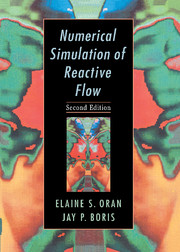Book contents
- Frontmatter
- Contents
- Prologue
- 1 An Overview of Numerical Simulation
- 2 The Reactive-Flow Modeling Problem
- 3 Models and Simulation
- 4 Some General Numerical Considerations
- 5 Ordinary Differential Equations: Reaction Mechanisms and Other Local Phenomena
- 6 Representations, Resolution, and Grids
- 7 Diffusive Transport Processes
- 8 Computational Fluid Dynamics: Continuity Equations
- 9 Computational Fluid Dynamics: Using More Flow Physics
- 10 Boundaries, Interfaces, and Implicit Algorithms
- 11 Coupling Models of Reactive-Flow Processes
- 12 Turbulent Reactive Flows
- 13 Radiation Transport and Reactive Flows
- Index
9 - Computational Fluid Dynamics: Using More Flow Physics
Published online by Cambridge University Press: 09 October 2009
- Frontmatter
- Contents
- Prologue
- 1 An Overview of Numerical Simulation
- 2 The Reactive-Flow Modeling Problem
- 3 Models and Simulation
- 4 Some General Numerical Considerations
- 5 Ordinary Differential Equations: Reaction Mechanisms and Other Local Phenomena
- 6 Representations, Resolution, and Grids
- 7 Diffusive Transport Processes
- 8 Computational Fluid Dynamics: Continuity Equations
- 9 Computational Fluid Dynamics: Using More Flow Physics
- 10 Boundaries, Interfaces, and Implicit Algorithms
- 11 Coupling Models of Reactive-Flow Processes
- 12 Turbulent Reactive Flows
- 13 Radiation Transport and Reactive Flows
- Index
Summary
Chapter 8 described numerical algorithms for solving continuity equations and presented straightforward methods to solve sets of continuity equations to simulate fluid systems. This chapter describes CFD methods that seek to improve the solution by incorporating more of the known flow physics. In some cases, additional constraints are added to the solution of the continuity equations. In other cases, the formulation of the problem itself is changed to use variables other than the primary conserved variables ρ, ρv, and E. The result is usually a more complicated algorithm and a less general numerical model. Sometimes, however, it can lead to a more accurate solution method for specific classes of problems.
This chapter first considers methods that exploit approximations based on the the flow speed. As discussed in Chapter 2 (Section 2–2.1, Table 2.2), flow speeds are generally divided into five regimes. In order of increasing Mach number, these are: incompressible, subsonic, transonic, supersonic, and hypersonic flows. The boundaries between these regimes loosely mark the appearance or disappearance of different physical phenomena, and each regime has peculiar features that make certain models and solution algorithms more effective. The material presented below describes methods for solving coupled flow problems in three speed regimes which are composites of those listed in Table 2.2.
Fast flows (see Section 9–2). In this regime the fluid velocity is at least a significant fraction of the speed of sound or faster. Compressibility effects, such as shocks, must be resolved.
[…]
- Type
- Chapter
- Information
- Numerical Simulation of Reactive Flow , pp. 286 - 352Publisher: Cambridge University PressPrint publication year: 2000



